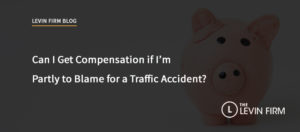 The short answer to this question is “yes.” The longer and more accurate answer is “sometimes.” When it comes to receiving compensation for a traffic accident, everything will depend on the facts and circumstances of your case, which your personal injury lawyer can analyze for you. If you or a loved one has been injured in a traffic accident, don’t put off calling a personal injury lawyer because you know you are partially responsible for the accident. You can still work to get the compensation you and your family need.
The short answer to this question is “yes.” The longer and more accurate answer is “sometimes.” When it comes to receiving compensation for a traffic accident, everything will depend on the facts and circumstances of your case, which your personal injury lawyer can analyze for you. If you or a loved one has been injured in a traffic accident, don’t put off calling a personal injury lawyer because you know you are partially responsible for the accident. You can still work to get the compensation you and your family need.
History Of Negligence Actions
When someone injures you in a traffic accident, you will probably sue for “negligence.” Basically, this is when you allege that the driver owed you a duty to drive with reasonable care and he fell short of that duty by speeding, swerving, or committing some other traffic violation. If the other driver’s negligence caused your injuries, you can typically recover compensation.
Pennsylvania law used to be fairly unforgiving if the injured driver was in any way negligent herself. In that situation, a person couldn’t sue at all—even if the other driver’s negligence caused catastrophic damage. This type of pure contributory negligence system prohibited plaintiffs from suing for negligence if their own negligence was even 1% responsible for the accident.
Comparative Fault Today
Fortunately, Pennsylvania has followed the lead of other states and realized the unfairness of a pure contributory negligence system. Now, you can recover compensation even if you are negligent—so long as you are not MORE negligent than the other party.
For example, a mother might sue a driver who rear-ends her, causing injuries to her child. However, it is discovered that the mother had failed to properly secure her child’s safety seat, so the child was thrown free and fell on the car floor. A jury finds that the mother is 50% responsible for her child’s injuries, and that the driver who rear-ended her is also 50% responsible. In this situation, the mother can receive compensation because she isn’t more responsible than the other driver.
Conversely, imagine if the mother had stepped on the brakes to make a left-hand turn without ever using her turn signal. After a driver rear-ends her, her child is thrown from the child seat that she had failed to properly secure. In this example, a jury might find that the mother is 75% responsible for her child’s injuries and the other driver is only 25% responsible. Because she is more responsible than the other driver, she cannot receive any compensation for her child’s injuries.
In short, Pennsylvania’s comparative fault system allows you to receive compensation if you were less than 51% responsible for the accident. Any percentage of fault over that amount will prohibit you from suing.
Evidence To Show Your Lawyer
It isn’t always easy to determine who is responsible for a traffic accident. Both sides will probably deny any responsibility, so the issue will be disputed if you go to trial. Your lawyer will need to fully assess the facts of your situation, including the following:
- The police report. The police report should apportion responsibility for the accident. Of course, the police officer’s opinion isn’t a fact that the jury must accept, but it is important evidence to know.
- Photographs of the scene of the accident. These can show where the vehicles ended up and if any obstructions (such as tree branches in front of stop signs) contributed to the accident.
- Photographs of the vehicles involved. Use your smartphone or ask someone else to take pictures.
- Witness testimony. Try to identify witnesses to the accident. The police report should name some, but you should also get names and contact information as well.
- Your own testimony about what you remember happening. Sit down as soon as possible after the accident and write down what you remember, if anything.
- Any surveillance or camera footage in the area. If the accident happened in a parking lot, then there should be surveillance footage.
- Cell phone records, which might show which drivers were texting or talking on the phone at the time of the accident.
- Medical records, which show your injury. Your injuries can sometimes reveal the angle of impact.
It is important to collect as much of this evidence as you can to show your personal injury lawyer at your initial consultation. If you hire a lawyer, your lawyer will also be able to help you find some of this information. For example, your attorney may subpoena the other driver’s cell phone records and visit the scene of the accident.
Estimating The Compensation You Can Receive
If you were less than 51% at fault, the good news is that you can still receive compensation for your injuries, which means money to compensate you for medical bills, lost wages, or pain and suffering. The bad news is that the amount you receive will be reduced by your percentage of fault.
Return to the example above. If a mother is 50% at fault for her child’s injury and a jury determines her losses to be worth $40,000, then she will only be able to get half of that amount, or $20,000. Her amount is reduced by her proportion of fault. By contrast, if the jury found she was 20% responsible for the injury, then she would get 80% of the verdict amount, or $32,000.
If you hope to settle your lawsuit, you should expect to settle for less if the evidence shows you were at least partially responsible for the crash. Any insurance adjuster will reduce the amount they offer you; however, you can still receive a meaningful settlement to help pay for your injuries and pain and suffering.
Talk To A Philadelphia Car Accident Lawyer Today
Being partially at fault for an accident doesn’t necessarily prevent you from getting the compensation you deserve. At The Levin Firm Personal Injury Lawyers, we have helped countless victims hold drivers responsible for their actions, even if our clients made some mistakes as well. Call us today for a free consultation and case evaluation at 215-825-5183, or fill out our contact form.
